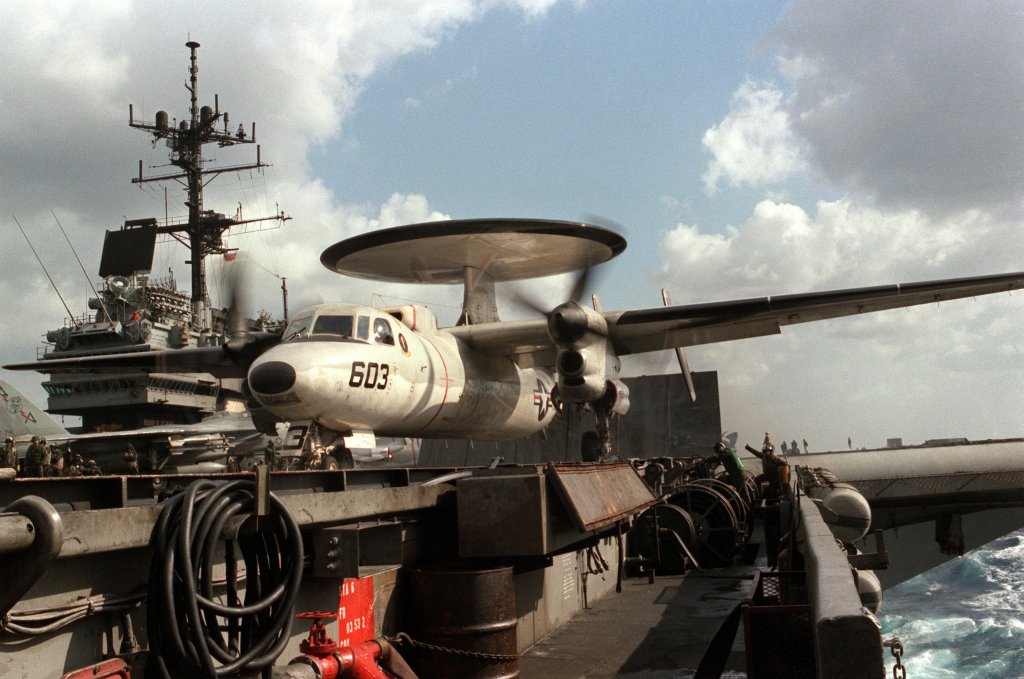The Handler and his minions hate having the E-2 moving around the flight deck.
The E-2 Hawkeye is the Navy’s all-weather, carrier-based tactical battle management airborne early warning, command, and control aircraft. The E-2 is a twin-engine, five crewmembers, high-wing turboprop aircraft with a 24-foot diameter radar rotodome attached to the upper fuselage.
The Hawkeye provides all-weather airborne early warning, airborne battle management, and command and control functions for the Carrier Strike Group and Joint Force Commander. Additional missions include surface surveillance coordination, air interdiction, offensive and defensive counter-air control, close air support coordination, time-critical strike coordination, search and rescue airborne coordination, and communications relay. An integral component of the Carrier Strike Group air wing, the E-2 uses computerized radar, Identification Friend or Foe, and electronic surveillance sensors to provide early warning, and threat analysis against potentially hostile air and surface targets.
Usually, Hawkeye is also the first aircraft to be launched from aircraft carriers at the beginning of day operations. Why?
‘Because the Handler and his minions hate having the E-2 moving around the flight deck. It’s big and bulky, with those two windmills of death just waiting for the unwary,’ says Andy Burns, US Navy Flight Officer with under 1500 hours in the Hawkeye, on Quora.
‘But seriously – getting an E-2 “up” and in position for launch makes moving everything else around the flight deck more difficult. Besides its sheer size, since it doesn’t have an Auxiliary Power Unit (APU), the E-2 needs to be supplied with external power until its onboard electrical generators (driven by the engines) are online, and there are only a few places on the flight deck with the necessary “deck edge power” connections.
‘The bow cats have those deck edge power connections nearby, so it’s just easiest to tow the E-2 there, getting it out of the way of all the other jets that need to be moved and “spotted,” before the next launch. When it’s time to start up for the next event, you get the Hummer started, spread, and launched first, and clear the deck for everyone else.
‘Of course, there’s always the risk that the plane will go “down” on the cat, and have to be pulled aft and one of the spare E-2s moved up for launch, in which case you can hear the Handler’s major arteries clanging shut across the ship.
‘So the E-2 is the first aircraft to be launched from carriers not “because the Hawkeye is the long-range eyes of the carrier group,” or to that effect. That’s not wrong, but it’s sort of obsolescent. That’s the Cold War answer, put it that way, when the E-2 had its original mission of defending the Battle Group against long-range Soviet aviation by detecting the bombers and guiding interceptors against them. Fleet air defense is still one of the E-2’s missions but it’s not a primary one anymore. In fact, the official designation for VAW squadrons was changed a couple of years ago, from “Carrier Airborne Early Warning” to “Airborne Command and Control.”’
Burns concludes;
‘The answer to the question of why the E-2 is always the first fixed-wing airborne on any given launch cycle, no matter what else is going on, is because it’s a pain in the ass to have it taxiing around the flight deck and makes it more difficult to move the other airplanes around. That’s really it.’

Photo by U.S. Navy

